#world fantasy
Text
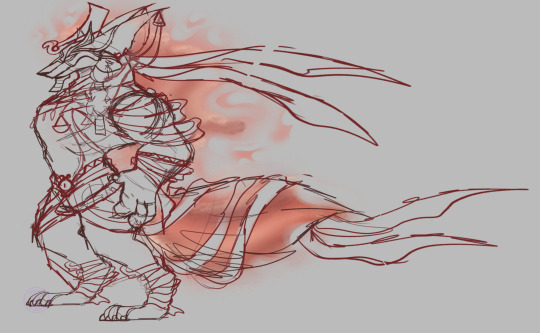

Here’s the concept for Deshret
He’s the Deity of Truth and makes sure that those spreading misinformation are punished and that said misinformation is stopped. He’s basically a very extreme reviewer and fact-checker that doesn’t let anything slide. If you are caught spreading falsehoods, get ready to get snatched and judged indiscriminately. Both the scales on his outfit and his ears act like scales and a way to verify your verdict. He will judge your heart to get to the bottom of it all. If your “heart” is heavy, get ready to be punished
Instagram - Patreon - Ko-fi
#Wip#oc#original character#worldbuilding#conceptart#concept sketch#world fantasy#nahda kingdom#paxinovis writing#characterart#myart#digitalart#creatureart#characterillustration#digitaldrawing#digitalillustration#digitalartist#His flowing “hair” is red sand
5 notes
·
View notes
Text
The Dance of Shadows is Payne’s first published novel, a high fantasy inspired by West African spirituality that follows a young musician drawn into a battle between gods. Described as “perfect for fans of the world-building of Marlon James, the musical magic of Patrick Rothfuss and the realistic characterisation of Joe Abercrombie”, the publisher says the book “marries the best of fantasy with a striking new take on magic and mythology as well as a hard look at the realities of colonialism".
We can't wait for you to meet Rumi! This trilogy is everything we love, and we are certain you are going to love it too.
14 notes
·
View notes
Text
a list of 100+ buildings to put in your fantasy town
academy
adventurer's guild
alchemist
apiary
apothecary
aquarium
armory
art gallery
bakery
bank
barber
barracks
bathhouse
blacksmith
boathouse
book store
bookbinder
botanical garden
brothel
butcher
carpenter
cartographer
casino
castle
cobbler
coffee shop
council chamber
court house
crypt for the noble family
dentist
distillery
docks
dovecot
dyer
embassy
farmer's market
fighting pit
fishmonger
fortune teller
gallows
gatehouse
general store
graveyard
greenhouses
guard post
guildhall
gymnasium
haberdashery
haunted house
hedge maze
herbalist
hospice
hospital
house for sale
inn
jail
jeweller
kindergarten
leatherworker
library
locksmith
mail courier
manor house
market
mayor's house
monastery
morgue
museum
music shop
observatory
orchard
orphanage
outhouse
paper maker
pawnshop
pet shop
potion shop
potter
printmaker
quest board
residence
restricted zone
sawmill
school
scribe
sewer entrance
sheriff's office
shrine
silversmith
spa
speakeasy
spice merchant
sports stadium
stables
street market
tailor
tannery
tavern
tax collector
tea house
temple
textile shop
theatre
thieves guild
thrift store
tinker's workshop
town crier post
town square
townhall
toy store
trinket shop
warehouse
watchtower
water mill
weaver
well
windmill
wishing well
wizard tower
#worldbuilding#setting prompts#writer resources#writing inspiration#writing prompts#scene settings#writing reference#writing ideas#prompt list#creative writing#writing community#writer prompts#writing tips#world#fantasy world#fantasy worldbuilding#high fantasy#world building#epic fantasy#writing fantasy
87K notes
·
View notes
Text
I Have Found A Solution!
So, obviously classic wizard robes aren’t wheelchair friendly. (Alright, admittedly this isn’t common knowledge and also this definitely isn’t a problem for most but listen, this is a problem for me and I’m pleased to present a solution for it nonetheless.)
The issue is in the sleeves and the length of the robes. The traditional trumpet style allows them to get snagged, dirty, and caught in the wheels.
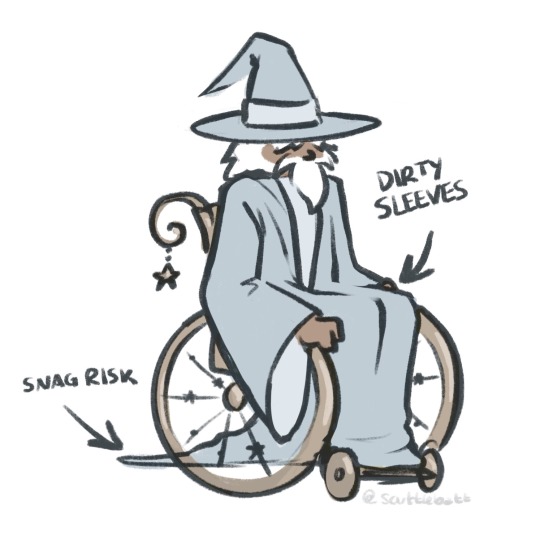
This is distinctly not an issue with other mobility aids such as canes and crutches, these wizards are fine to carry on with their trumpet sleeves simply rolled up if needed.

Now, one solution might simply to shorten the sleeves and hem to be out of the way, but that looks rather silly so I won’t do that. Instead I propose the more elegant design of a hanging sleeve to maintain that flowy magical feel while allowing for better range of motion.

Honestly I just love the look of hanging sleeves in general and think more people should appreciate them, wheelchair user or not.

In conclusion…
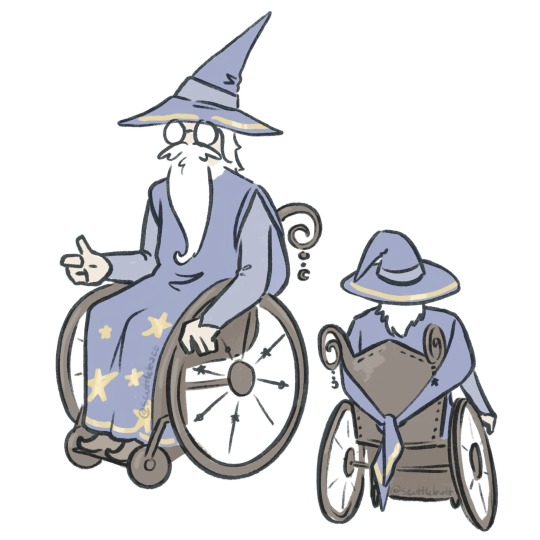
#this is basically free character design hacks baybe so go make your fantasy worlds accessible and inclusive or else#digital illustration#wizard posting#wheelchair wizards#my art
44K notes
·
View notes
Text
mary shelley writing about a monster rejected and abandoned by its creator and dedicating it to her own father i need to smoke a blunt with her i need to give her head
#there are parallels even in the creature’s journey to geneva to find frankenstein and matilda’s fantasies of a pilgrimage across the world#in search of her father#searching for eden finding yourself in hell#the fall into monsterous womanhood#and so on
86K notes
·
View notes
Text

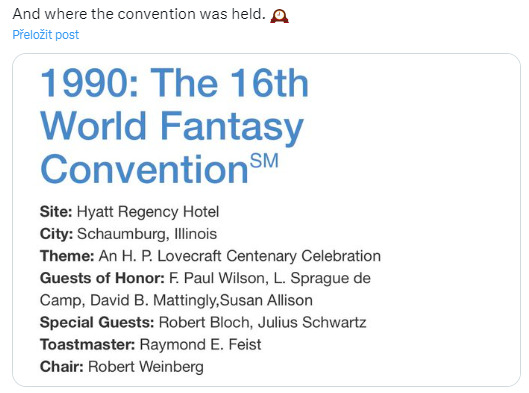





❤❤❤ (tweet ❤)
#good omens#terry pratchett#neil gaiman#photos#terry and neil#btb#16th world fantasy convention#hyatt regency hotel#fun fact
20K notes
·
View notes
Text

miku but she's from orgrimmar
#art#drawing#fantasy#digital art#hatsune miku#miku#miku fanart#orc#orc woman#orc female#female orc#greenskins#green skin#buff#buff girl#buff woman#mikuposting#wow#world of warcraft
5K notes
·
View notes
Text
"mithrun is the only real monsterfucker in dungeon meshi" is objectively the funniest bit you can get out of his everything, but in all seriousness i think his attraction to his love interest is deliberately overstated—and that makes sense, because romantic jealousy is a classic and digestible motive, which is explicitly what kabru was aiming for in condensing mithrun's backstory, and also because until chapter 94, mithrun wasn't willing to admit to the true nature of his desires.


but because romantic envy is both classic and digestible, it probably isn’t a unique enough or complicated enough desire to tempt a demon’s appetite. mithrun’s wish, as far as we can figure from kabru’s reduced retelling, was to have a life in which he had never become one of the canaries, and that carries like 3857 implications and desires within it. that’s delicious. his love interest acts as sort of a red herring to his motivation for making it, though. (side note: i'm saying "love interest" here because, keeping in mind that i barely speak japanese on a good day anymore, "想い人" is something i'd usually take as just kind of an old-fashioned and romantic way to refer to a lover, but in context i wonder if both the connotation of yearning and the vagueness are intentional, and i think this phrasing gets those aspects of it more effectively. anyway.)
mithrun considered his love interest to be untrustworthy. there was a minute where i thought that comment might be about a similar-looking elf (yugin, one of his squad members), but comparing the two…
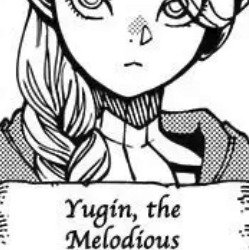

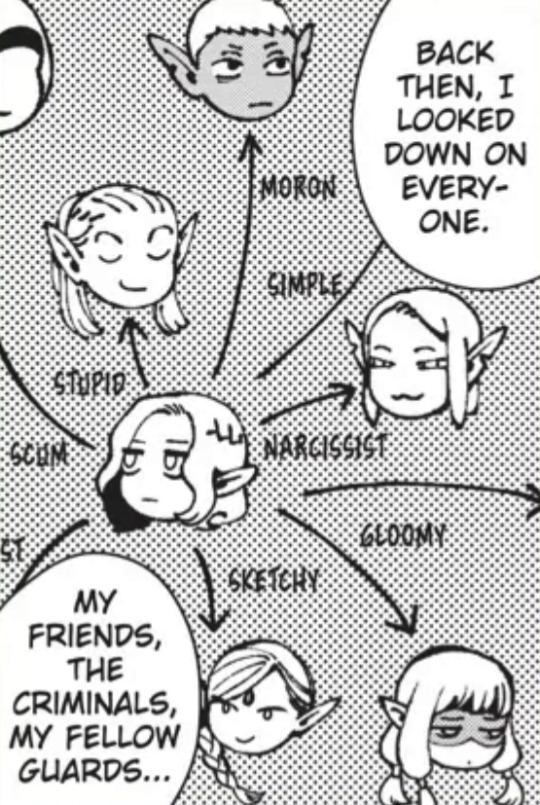
the "sketchy" arrow is definitely referring to the elf we know as his love interest—the bangs go toward her right, she only has the one forehead ornament, and, most notably, her ears aren't notched.
every time she’s given a full-body depiction in his dungeon, she’s drawn as a chimera, with the body of a snake from the waist down. (side note: the “what if a dungeon has chimeras before reaching level 4?”/“then the dungeon lord is unstable” exchange just being mithrun grilling his past self alive is so funny. he’s so. but anyway) there are a couple things about this.
first, the snake part of the chimera appears to be modeled after some species of coral snake mimic

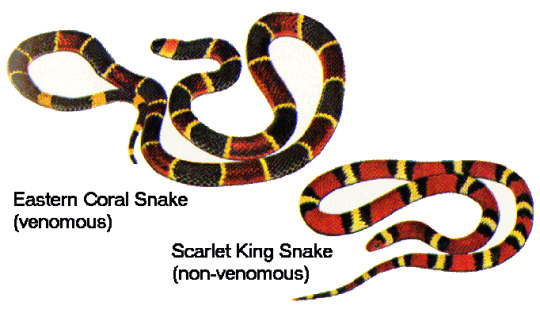
which, in the biology-for-fun manga, i… doubt is a coincidence, especially with the added context of the “untrustworthy” comment. the dungeon’s conjured illusion of mithrun’s love interest was a harmless copycat of a venomous original. for whatever reason, he felt this person was a threat and made up a "safe" version of her to be in a relationship with, and while it’s definitely possible to be attracted to or even love someone you find to be toxic and/or intimidating, when you take that into consideration alongside the configuration of her body, you get some interesting implications.
which brings us to our second point: if we assume that mithrun was not in fact fucking a snake, then sexual attraction, at least, was so far removed from his idea of a relationship with this person that he did not even bother to keep her dungeon copy human enough to maintain the illusion of the option of a sexual relationship. this is somewhat echoed in the depictions of their interactions, which also imply a frankly unexpected romantic distance. she kisses his cheek and he doesn't seem to react; she's at the edge of a narrow bed with only one set of pillows, on top of his blankets while he's underneath them.
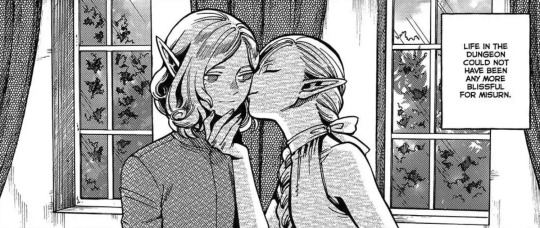
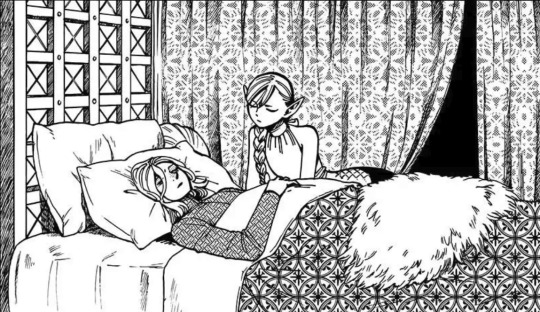
the kiss is particularly interesting because it seems to contrast the text. kabru's narration tells us this was everything mithrun could have asked for, but mithrun is there looking unreadable to pensive, likely because this is right before the panel that makes it clear things in the dungeon are beginning to go wrong.
walking through this backwards for a minute, we have the physical barrier of his bedding and the spatial separation inherent in a bed made for one person, the emotional barrier of his mounting anxiety getting in the way of his ability to enjoy the affection he sought, and... the snake, which historically carries the connotation of temptation, yes, but also mistrust, barring physical intimacy. okay. ok. if a dungeon reflects the mentality of its lord, all of this might suggest that mithrun was not able to have any real desire for a relationship with this person. his unwillingness to be vulnerable or let another person in was insurmountable. but in that case, why was she such a focal point that she remained to the end, after his dungeon had stopped creating iterations of his friends to come and visit him? why would he get so upset over her meeting with his brother that he became lord of a dungeon about it?
well. mithrun's brother was also interested in her, probably genuinely. and mithrun had to win.
you have an older brother who your parents completely ignore, probably in part because he is chronically ill/disabled and almost definitely in part because he received a ton of recessive traits that resulted in rumors that he was an illegitimate child. you are aware, most likely because those same parents fucking told you, that you actually are an illegitimate child. but they keep you around because you had the good fortune of looking just like your mother. what can that possibly teach you but that you, like your brother, are disposable?
it's utterly unsurprising that mithrun, under these circumstances, developed a pathological need to be better than everyone around him. people don't keep you otherwise. i'd argue this is also why he says he looked down on everyone he knew while milsiril claims his dungeon reeked of feelings of inferiority—he sought out people's worst traits and prioritized them in his mind to protect his already extremely fragile sense of self-worth, and all the while he tried to be as likable and high-performing as he possibly could be. his parents disposed of him anyway, but even then he tried to keep up the performance. he was kind to everyone. he never once lost to a dungeon.
when he saw his "love interest" meeting up with his brother, what he saw was himself being replaced by a person his parents had always treated as worthless, and if that was what they thought of the child they'd kept, what value could anyone possibly see in the bastard they'd given away to die? mithrun and kabru tell the story like he wanted to win this unnamed elf's heart, but it was never about being with her. it was about cementing his worth, proving that he didn't deserve to be thrown away.
and so it's particularly cruel that his demon discarded him, too. but maybe it's also particularly gentle that, in the end, there was someone who refused to even consider giving up on him.
kui laid it out in three panels better than i could hope to.
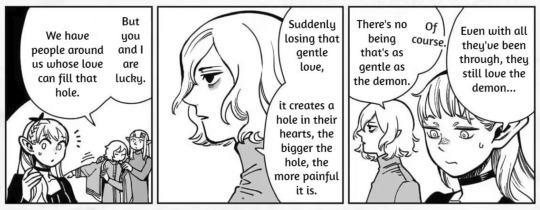
yeah. it's love. you wanted to be loved, even when the only way you were able to understand it was through the desire to be wanted, and you wanted that so badly that the idea of being consumed felt like the promise of finally mattering to someone.
#dungeon meshi spoilers#mithrun#dungeon meshi#this has been rotating for a while but i wanted to check my evidence before getting into it thanks user angelspenance for posting that meme#half of this is just the text and the other half i'm sure has been said before but it's making my brain [radio static] so here this is#someone did for sure mention this but i do find it very cute that in his fucked up conjured world meant to portray his ideal reality#his teammates came to visit him. like part of the fantasy was then explicitly that they cared about him and were his friends. even though#he says he tried to see the worst in them.#hm it does feel important to note that i do also believe 100% in mithrun suicidality--his desire to be eaten does seem to focus a lot on#wanting it to be Over. wanting not to be left incomplete and empty anymore.#but that loops back around a bit to the hole in your heart that appears when you feel unloved. it's many things and the same thing at once#snakes#long post#severe problems#meshy
9K notes
·
View notes
Text

This came across my Facebook feed, felt I’d share it.
49K notes
·
View notes
Text
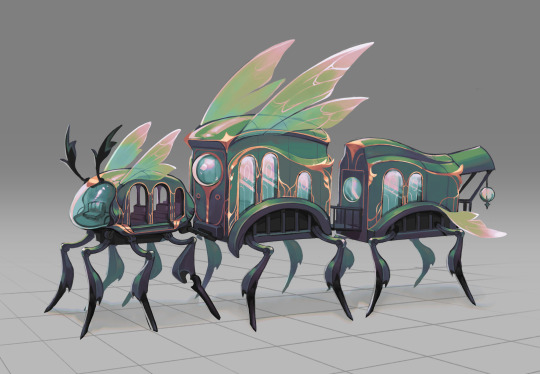
bug bus bug bus bug bus!!!
#concept art#world development#vehicle design#fantasy art#art nouveau#zero art#piece for a visdev class! rare chance to do something other than characters
6K notes
·
View notes
Text
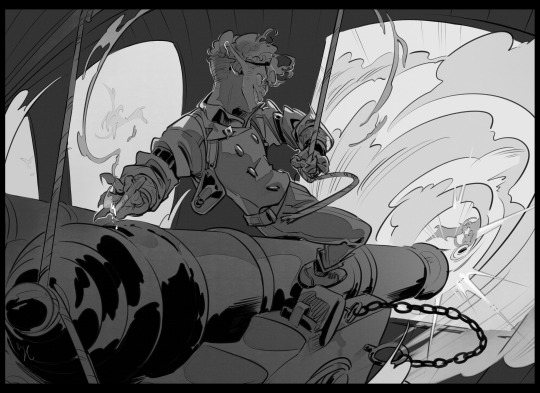
beautiful! majestic!
#riz gukgak#dimension 20#fantasy high junior year#fhjy spoilers#saw someone else's art that was so cool I blacked out for a few hours and woke up to this on my screen#foolish of me to have the thought ''oh he's smoking he's absolutely lighting these cannons with his smoke right'' and then#almost not draw it#like. cmon#bringing over my tags from another post here. I think firing those cannons was like the closest this kid's come to a moment of mindfulness#kid was doing self searching n introspection on top of those guns. eugenia got there at the breakthrough#I believe in you baby boy. rob a bank get that tuition the world is your oyster
7K notes
·
View notes
Text
The God of Soil and Wisdom is the youngest of the 3 Elder or Eco gods, comprising of: Mamá Mayna, Goddess of Flowers and Art, and Alagbede, God of Rock and Craftmanship. The name of this god is Nabu Maat, but their people have given them the title of Ozymandias Misr. They have 3 children, being the 3 Deital Pharaohs that rule over the Nahda Kingdom. They are:
Kemet, Deity of Knowledge
Hedjet, Deity of Writing
Deshret, Deity of Truth
Each rule over a portion of the Nahda Kingdom’s land. The lush and fertile land of Kememphi to Kemet, where lush forests and black soil flourish. The slick and muddy land of Hedjebai belongs to Hedjet, where the river deposits sediments. The dusty and arid land of Deshara belongs to Deshret, where the hot desert is your home.
In the image of his children, Nabu Maat created different races. In the image of Kemet, they created the Sphinx and the bastaens or felems. In the image of Hedjet, they created the Knu and the baens. In the image of Deshret, they created the Anubi and nyuwi or canems.
2 notes
·
View notes
Text
another thing fantasy writers should keep track of is how much of their worldbuilding is aesthetic-based. it's not unlike the sci-fi hardness scale, which measures how closely a story holds to known, real principles of science. The Martian is extremely hard sci-fi, with nearly every detail being grounded in realistic fact as we know it; Star Trek is extremely soft sci-fi, with a vaguely plausible "space travel and no resource scarcity" premise used as a foundation for the wildest ideas the writers' room could come up with. and much as Star Trek fuckin rules, there's nothing wrong with aesthetic-based fantasy worldbuilding!
(sidenote we're not calling this 'soft fantasy' bc there's already a hard/soft divide in fantasy: hard magic follows consistent rules, like "earthbenders can always and only bend earth", and soft magic follows vague rules that often just ~feel right~, like the Force. this frankly kinda maps, but I'm not talking about just the magic, I'm talking about the worldbuilding as a whole.
actually for the purposes of this post we're calling it grounded vs airy fantasy, bc that's succinct and sounds cool.)
a great example of grounded fantasy is Dungeon Meshi: the dungeon ecosystem is meticulously thought out, the plot is driven by the very realistic need to eat well while adventuring, the story touches on both social and psychological effects of the whole 'no one dies forever down here' situation, the list goes on. the worldbuilding wants to be engaged with on a mechanical level and it rewards that engagement.
deliberately airy fantasy is less common, because in a funny way it's much harder to do. people tend to like explanations. it takes skill to pull off "the world is this way because I said so." Narnia manages: these kids fall into a magic world through the back of a wardrobe, befriend talking beavers who drink tea, get weapons from Santa Claus, dance with Bacchus and his maenads, and sail to the edge of the world, without ever breaking suspension of disbelief. it works because every new thing that happens fits the vibes. it's all just vibes! engaging with the worldbuilding on a mechanical level wouldn't just be futile, it'd be missing the point entirely.
the reason I started off calling this aesthetic-based is that an airy story will usually lean hard on an existing aesthetic, ideally one that's widely known by the target audience. Lewis was drawing on fables, fairy tales, myths, children's stories, and the vague idea of ~medieval europe~ that is to this day our most generic fantasy setting. when a prince falls in love with a fallen star, when there are giants who welcome lost children warmly and fatten them up for the feast, it all fits because these are things we'd expect to find in this story. none of this jars against what we've already seen.
and the point of it is to be wondrous and whimsical, to set the tone for the story Lewis wants to tell. and it does a great job! the airy worldbuilding serves the purposes of the story, and it's no less elegant than Ryōko Kui's elaborately grounded dungeon. neither kind of worldbuilding is better than the other.
however.
you do have to know which one you're doing.
the whole reason I'm writing this is that I saw yet another long, entertaining post dragging GRRM for absolute filth. asoiaf is a fun one because on some axes it's pretty grounded (political fuck-around-and-find-out, rumors spread farther than fact, fastest way to lose a war is to let your people starve, etc), but on others it's entirely airy (some people have magic Just Cause, the various peoples are each based on an aesthetic/stereotype/cliché with no real thought to how they influence each other as neighbors, the super-long seasons have no effect on ecology, etc).
and again! none of this is actually bad! (well ok some of those stereotypes are quite bigoted. but other than that this isn't bad.) there's nothing wrong with the season thing being there to highlight how the nobles are focused on short-sighted wars for power instead of storing up resources for the extremely dangerous and inevitable winter, that's a nice allegory, and the looming threat of many harsh years set the narrative tone. and you can always mix and match airy and grounded worldbuilding – everyone does it, frankly it's a necessity, because sooner or later the answer to every worldbuilding question is "because the author wanted it to be that way." the only completely grounded writing is nonfiction.
the problem is when you pretend that your entirely airy worldbuilding is actually super duper grounded. like, for instance, claiming that your vibes-based depiction of Medieval Europe (Gritty Edition) is completely historical, and then never even showing anyone spinning. or sniffing dismissively at Tolkien for not detailing Aragorn's tax policy, and then never addressing how a pre-industrial grain-based agricultural society is going years without harvesting any crops. (stored grain goes bad! you can't even mouse-proof your silos, how are you going to deal with mold?) and the list goes on.
the man went up on national television and invited us to engage with his worldbuilding mechanically, and then if you actually do that, it shatters like spun sugar under the pressure. doesn't he realize that's not the part of the story that's load-bearing! he should've directed our focus to the political machinations and extensive trope deconstruction, not the handwavey bit.
point is, as a fantasy writer there will always be some amount of your worldbuilding that boils down to 'because I said so,' and there's nothing wrong with that. nor is there anything wrong with making that your whole thing – airy worldbuilding can be beautiful and inspiring. but you have to be aware of what you're doing, because if you ask your readers to engage with the worldbuilding in gritty mechanical detail, you had better have some actual mechanics to show them.
#finx rambles#worldbuilding#for writers#honestly I quite liked the asoiaf books I read#it's a well-constructed story! it's a well-constructed world too on its own merits#none of this stuff about grain and spinning is actually important to the story#the problem is that grrm himself seems to just. not realize this#and goes about blithely insisting he's created an extraordinarily realistic fantasy world where all the tax policies make sense#he has not!#he has invited people to tear his creation apart if they can and! it turns out! they absolutely can!#this shit's got no tensile strength! it's made of glue and popsicle sticks!#you're not supposed to put weight on it
4K notes
·
View notes
Text

As if "swallowed by the earth" is a way to describe someone who's gone missing without a trace, particularly in the woods, but in Ditovo it may be more than just a saying. At least if you believe the many legends and folktales about giant plumsaina, or as they're more commonly known "earth belly". The plant does exist but usually it is only big enough to catch small vertebrates, which it does when prey step onto its camouflaged trap door and fall into the pit of the plant filled with digestive liquid and downward pointing spikes preventing escape. The roots of the plant are for storing nutrients and other substances, as well as firmly anchoring the plant in the ground when prey is thrashing about inside it. In order to reproduce the earth belly sprouts a red flower above the surface, a red flag that may perhaps save the life of one who recognizes it.
#original species#worldbuilding#world building#plant design#fantasy species#fantasy plant#flora#cursed papaya looking spud
4K notes
·
View notes
Text
How Do I Make My Fictional Gypsies Not Racist?
(Or, "You can't, sorry, but…")
You want to include some Gypsies in your fantasy setting. Or, you need someone for your main characters to meet, who is an outsider in the eyes of the locals, but who already lives here. Or you need a culture in conflict with your settled people, or who have just arrived out of nowhere. Or, you just like the idea of campfires in the forest and voices raised in song. And you’re about to step straight into a muckpile of cliches and, accidentally, write something racist.
(In this, I am mostly using Gypsy as an endonym of Romany people, who are a subset of the Romani people, alongside Roma, Sinti, Gitano, Romanisael, Kale, etc, but also in the theory of "Gypsying" as proposed by Lex and Percy H, where Romani people are treated with a particular mix of orientalism, criminalisation, racialisation, and othering, that creates "The Gypsy" out of both nomadic peoples as a whole and people with Romani heritage and racialised physical features, languages, and cultural markers)
Enough of my friends play TTRPGs or write fantasy stories that this question comes up a lot - They mention Dungeons and Dragons’ Curse Of Strahd, World Of Darkness’s Gypsies, World Of Darkness’s Ravnos, World of Darkness’s Silent Striders… And they roll their eyes and say “These are all terrible! But how can I do it, you know, without it being racist?”
And their eyes are big and sad and ever so hopeful that I will tell them the secret of how to take the Roma of the real world and place them in a fictional one, whilst both appealing to gorjer stereotypes of Gypsies and not adding to the weight of stereotyping that already crushes us. So, disappointingly, there is no secret.
Gypsies, like every other real-world culture, exist as we do today because of interactions with cultures and geography around us: The living waggon, probably the archetypal thing which gorjer writers want to include in their portrayals of nomads, is a relatively modern invention - Most likely French, and adopted from French Showmen by Romanies, who brought it to Britain. So already, that’s a tradition that only spans a small amount of the time that Gypsies have existed, and only a small number of the full breadth of Romani ways of living. But the reasons that the waggon is what it is are based on the real world - The wheels are tall and iron-rimmed, because although you expect to travel on cobbled, tarmac, or packed-earth roads and for comparatively short distances, it wasn’t rare to have to ford a river in Britain in the late nineteenth century, on country roads. They were drawn by a single horse, and the shape of that horse was determined by a mixture of local breeds - Welsh cobs, fell ponies, various draft breeds - as well as by the aesthetic tastes of the breeders. The stove inside is on the left, so that as you move down a British road, the chimney sticks up into the part where there will be the least overhanging branches, to reduce the chance of hitting it.
So taking a fictional setting that looks like (for example) thirteenth century China (with dragons), and placing a nineteenth century Romanichal family in it will inevitably result in some racist assumptions being made, as the answer to “Why does this culture do this?” becomes “They just do it because I want them to” rather than having a consistent internal logic.
Some stereotypes will always follow nomads - They appear in different forms in different cultures, but they always arise from the settled people's same fears: That the nomads don't share their values, and are fundamentally strangers. Common ones are that we have a secret language to fool outsiders with, that we steal children and disguise them as our own, that our sexual morals are shocking (This one has flipped in the last half century - From the Gypsy Lore Society's talk of the lascivious Romni seductress who will lie with a strange man for a night after a 'gypsy wedding', to today's frenzied talk of 'grabbing' and sexually-conservative early marriages to ensure virginity), that we are supernatural in some way, and that we are more like animals than humans. These are tropes where if you want to address them, you will have to address them as libels - there is no way to casually write a baby-stealing, magical succubus nomad without it backfiring onto real life Roma. (The kind of person who has the skills to write these tropes well, is not the kind of person who is reading this guide.)
It’s too easy to say a list of prescriptive “Do nots”, which might stop you from making the most common pitfalls, but which can end up with your nomads being slightly flat as you dance around the topics that you’re trying to avoid, rather than being a rich culture that feels real in your world.
So, here are some questions to ask, to create your nomadic people, so that they will have a distinctive culture of their own that may (or may not) look anything like real-world Romani people: These aren't the only questions, but they're good starting points to think about before you make anything concrete, and they will hopefully inspire you to ask MORE questions.
First - Why are they nomadic? Nobody moves just to feel the wind in their hair and see a new horizon every morning, no matter what the inspirational poster says. Are they transhumant herders who pay a small rent to graze their flock on the local lord’s land? Are they following migratory herds across common land, being moved on by the cycle of the seasons and the movement of their animals? Are they seasonal workers who follow man-made cycles of labour: Harvests, fairs, religious festivals? Are they refugees fleeing a recent conflict, who will pass through this area and never return? Are they on a regular pilgrimage? Do they travel within the same area predictably, or is their movement governed by something that is hard to predict? How do they see their own movements - Do they think of themselves as being pushed along by some external force, or as choosing to travel? Will they work for and with outsiders, either as employees or as partners, or do they aim to be fully self-sufficient? What other jobs do they do - Their whole society won’t all be involved in one industry, what do their children, elderly, disabled people do with their time, and is it “work”?
If they are totally isolationist - How do they produce the things which need a complex supply chain or large facilities to make? How do they view artefacts from outsiders which come into their possession - Things which have been made with technology that they can’t produce for themselves? (This doesn’t need to be anything about quality of goods, only about complexity - A violin can be made by one artisan working with hand tools, wood, gut and shellac, but an accordion needs presses to make reeds, metal lathes to make screws, complex organic chemistry to make celluloid lacquer, vulcanised rubber, and a thousand other components)
How do they feel about outsiders? How do they buy and sell to outsiders? If it’s seen as taboo, do they do it anyway? Do they speak the same language as the nearby settled people (With what kind of fluency, or bilingualism, or dialect)? Do they intermarry, and how is that viewed when it happens? What stories does this culture tell about why they are a separate people to the nearby settled people? Are those stories true? Do they have a notional “homeland” and do they intend to go there? If so, is it a real place?
What gorjers think of as classic "Gipsy music" is a product of our real-world situation. Guitar from Spain, accordions from the Soviet Union (Which needed modern machining and factories to produce and make accessible to people who weren't rich- and which were in turn encouraged by Soviet authorities preferring the standardised and modern accordion to the folk traditions of the indigenous peoples within the bloc), brass from Western classical traditions, via Balkan folk music, influences from klezmer and jazz and bhangra and polka and our own music traditions (And we influence them too). What are your people's musical influences? Do they make their own instruments or buy them from settled people? How many musical traditions do they have, and what are they all for (Weddings, funerals, storytelling, campfire songs, entertainment...)? Do they have professional musicians, and if so, how do those musicians earn money? Are instrument makers professionals, or do they use improvised and easy-to-make instruments like willow whistles, spoons, washtubs, etc? (Of course the answer can be "A bit of both")
If you're thinking about jobs - How do they work? Are they employed by settled people (How do they feel about them?) Are they self employed but providing services/goods to the settled people? Are they mostly avoidant of settled people other than to buy things that they can't produce themselves? Are they totally isolationist? Is their work mostly subsistence, or do they create a surplus to sell to outsiders? How do they interact with other workers nearby? Who works, and how- Are there 'family businesses', apprentices, children with part time work? Is it considered 'a job' or just part of their way of life? How do they educate their children, and is that considered 'work'? How old are children when they are considered adult, and what markers confer adulthood? What is considered a rite of passage?
When they travel, how do they do it? Do they share ownership of beasts of burden, or each individually have "their horse"? Do families stick together or try to spread out? How does a child begin to live apart from their family, or start their own family? Are their dwellings something that they take with them, or do they find places to stay or build temporary shelter with disposable material? Who shares a dwelling and why? What do they do for privacy, and what do they think privacy is for?
If you're thinking about food - Do they hunt? Herd? Forage? Buy or trade from settled people? Do they travel between places where they've sown crops or managed wildstock in previous years, so that when they arrive there is food already seeded in the landscape? How do they feel about buying food from settled people, and is that common? If it's frowned upon - How much do people do it anyway? How do they preserve food for winter? How much food do they carry with them, compared to how much they plan to buy or forage at their destinations? How is food shared- Communal stores, personal ownership?
Why are they a "separate people" to the settled people? What is their creation myth? Why do they believe that they are nomadic and the other people are settled, and is it correct? Do they look different? Are there legal restrictions on them settling? Are there legal restrictions on them intermixing? Are there cultural reasons why they are a separate people? Where did those reasons come from? How long have they been travelling? How long do they think they've been travelling? Where did they come from? Do they travel mostly within one area and return to the same sites predictably, or are they going to move on again soon and never come back?
And then within that - What about the members of their society who are "unusual" in some way: How does their society treat disabled people? (are they considered disabled, do they have that distinction and how is it applied?) How does their society treat LGBT+ people? What happens to someone who doesn't get married and has no children? What happens to someone who 'leaves'? What happens to young widows and widowers? What happens if someone just 'can't fit in'? What happens to someone who is adopted or married in? What happens to people who are mixed race, and in a fantasy setting to people who are mixed species? What is taboo to them and what will they find shocking if they leave? What is society's attitude to 'difference' of various kinds?
Basically, if you build your nomads from the ground-up, rather than starting from the idea of "I want Gypsies/Buryats/Berbers/Minceiri but with the numbers filed off and not offensive" you can end up with a rich, unique nomadic culture who make sense in your world and don't end up making a rod for the back of real-world cultures.
7K notes
·
View notes
Text
Principles and Laws of Magic for Fantasy Writers
Fundamental Laws
1. Law of Conservation of Magic- Magic cannot be created or destroyed, only transformed.
3. Law of Equivalent Exchange- To gain something, an equal value must be given.
5. Law of Magical Exhaustion- Using magic drains the user’s energy or life force.
Interaction and Interference
4. Law of Magical Interference- Magic can interfere with other magical effects.
6. Law of Magical Contamination- Magic can have unintended side effects.
8. Law of Magical Inertia- Magical effects continue until stopped by an equal or greater force.
Resonance and Conditions
7. Law of Magical Resonance- Magic resonates with certain materials, places, or times.
9. Law of Magical Secrecy- Magic must be kept secret from the non-magical world.
11. Law of Magical Hierarchy- Different types of magic have different levels of power and difficulty.
Balance and Consequences
10. Law of Magical Balance- Every positive magical effect has a negative consequence.
12. Law of Magical Limitation- Magic has limits and cannot solve every problem.
14. Law of Magical Rebound- Misused magic can backfire on the user.
Special Conditions
13. Law of Magical Conduits- Certain objects or beings can channel magic more effectively.
15. Law of Magical Cycles- Magic may be stronger or weaker depending on cycles (e.g., lunar phases).
17. Law of Magical Awareness- Some beings are more attuned to magic and can sense its presence.
Ethical and Moral Laws
16. Law of Magical Ethics- Magic should be used responsibly and ethically.
18. Law of Magical Consent- Magic should not be used on others without their consent.
20. Law of Magical Oaths- Magical promises or oaths are binding and have severe consequences if broken.
Advanced and Rare Laws
19. Law of Magical Evolution- Magic can evolve and change over time.
20. Law of Magical Singularities- Unique, one-of-a-kind magical phenomena exist and are unpredictable.
Unique and Imaginative Magical Laws
- Law of Temporal Magic- Magic can manipulate time, but with severe consequences. Altering the past can create paradoxes, and using time magic ages the caster rapidly.
- Law of Emotional Resonance- Magic is amplified or diminished by the caster’s emotions. Strong emotions like love or anger can make spells more powerful but harder to control.
- Law of Elemental Harmony- Magic is tied to natural elements (fire, water, earth, air). Using one element excessively can disrupt the balance and cause natural disasters.
- Law of Dream Magic- Magic can be accessed through dreams. Dreamwalkers can enter others’ dreams, but they risk getting trapped in the dream world.
- Law of Ancestral Magic- Magic is inherited through bloodlines. The strength and type of magic depend on the caster’s ancestry, and ancient family feuds can influence magical abilities.
- Law of Symbiotic Magic- Magic requires a symbiotic relationship with magical creatures. The caster and creature share power, but harming one affects the other.
- Law of Forgotten Magic- Ancient spells and rituals are lost to time. Discovering and using forgotten magic can yield great power but also unknown dangers.
- Law of Magical Echoes- Spells leave behind echoes that can be sensed or traced. Powerful spells create stronger echoes that linger longer.
- Law of Arcane Geometry- Magic follows geometric patterns. Spells must be cast within specific shapes or alignments to work correctly.
- Law of Celestial Magic- Magic is influenced by celestial bodies. Spells are stronger during certain astronomical events like eclipses or planetary alignments.
- Law of Sentient Magic- Magic has a will of its own. It can choose to aid or hinder the caster based on its own mysterious motives.
- Law of Shadow Magic- Magic can manipulate shadows and darkness. Shadowcasters can travel through shadows but are vulnerable to light.
- Law of Sympathetic Magic- Magic works through connections. A spell cast on a representation of a person (like a doll or portrait) affects the actual person.
- Law of Magical Artifacts- Certain objects hold immense magical power. These artifacts can only be used by those deemed worthy or who possess specific traits.
- Law of Arcane Paradoxes- Some spells create paradoxes that defy logic. These paradoxes can have unpredictable and often dangerous outcomes.
- Law of Elemental Fusion- Combining different elemental magics creates new, hybrid spells with unique properties and effects.
- Law of Ethereal Magic- Magic can interact with the spirit world. Ethereal mages can communicate with spirits, but prolonged contact can blur the line between life and death.
- Law of Arcane Symbiosis- Magic can bond with technology, creating magical machines or enchanted devices with extraordinary capabilities.
- Law of Dimensional Magic- Magic can open portals to other dimensions. Dimensional travelers can explore alternate realities but risk getting lost or encountering hostile beings.
- Law of Arcane Sacrifice- Powerful spells require a sacrifice, such as a cherished memory, a personal item, or even a part of the caster’s soul.
---
✨ Hello, I'm Kali, The Plot Mage! ✨
I’m here to ignite your creativity and help you craft your next bestseller! Today is your lucky day, writer! 🪄 Whether you're battling writer's block or building an epic fantasy world, I've got just the tool you need to make your writing journey enjoyable and organized.
Introducing the all-in-one writer’s toolkit designed by a fellow fantasy writer. 🌟 This comprehensive resource includes:
- An in-depth worldbuilding worksheet (covering religion, lore, factions, currency, economics, and more)
- Character development worksheet
- Series roadmap
- Outlining and guided plot planning section
- Relationship dynamic worksheet
- Idea dump and a repository of helpful writing resources
- Task planner (from brainstorming to publishing and book marketing)
- Plus, free editable wanted posters and fantasy illustrations because you're special ❤️
✨ Use code "F4NTASY" for a magical 75% off! ✨
Happy writing, and let’s bring your fantasy world to life! 🌈📚






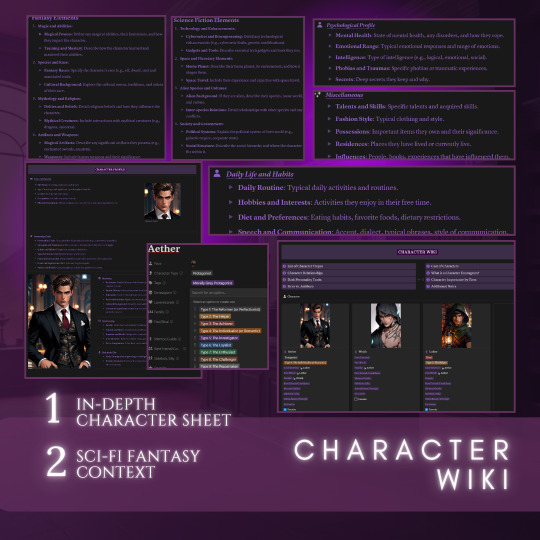
#writer#writing#writer things#writerblr#writerscorner#writing inspiration#writing tips#author#writers and poets#ao3 writer#writeblr#fantasy writer#sci fi and fantasy#writing inspo#writing resources#dnd campaign#dnd character#character development#original character#amwriting#writers community#writer stuff#writing blog#writers block#writerscommunity#worldbuilding#world building#fantasy series
3K notes
·
View notes